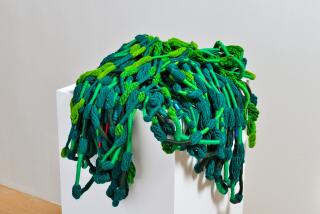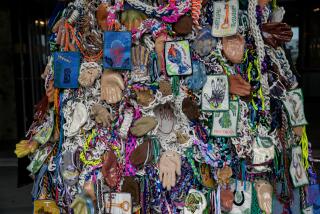Bosnian Refugees Create Beauty From Chaos
- Share via
Art is often therapy for regenerating lives torn by tragedy or disability. Textiles created by Bosnian refugees are moving examples of this age-old tradition.
The women’s work, from the Susret Art Workshop in Frastanz, Austria, is on view at the Pacific Design Center in Los Angeles from mid-November to the end of the year.
The refugees made the rugs, tapestries and quilts by hand from designs created by professionals. Everything in the exhibit is for sale, with prices ranging from $1,000 to $5,000 each.
Susret is the Serbo-Croatian word meaning to encounter, touch or reach out. The workshop’s goal is to build an art textile manufacturing business that can support the women once they return to Bosnia.
“Most of the refugees do want to go back, despite everything that has happened to them, but they have to have a means of support in order to do so,” according to Gerlinde Manz-Christ, Austrian consul in New York.
The Austrian Consulate is a co-sponsor of the exhibition, and the Austrian government subsidizes the nonprofit Susret refugee center.
The genesis of Susret was in 1992 when Dr. Gertrud Wuerbel, a psychoanalyst, began counseling Bosnian refugees at the center. The women, whose work history ranged from shepherd to university professor, lost jobs, homes and families in the war, and some had been raped.
“The arts are a great healer, and any form of craft and artisanry occupies and focuses the mind,” according to Wuerbel, who also counseled Holocaust survivors.
Bosnia is a traditional center of carpet weaving, and several of the women were accomplished in needlework, so Wuerbel encouraged the women to work with textiles. The needleworkers and two volunteer textile artists trained the other women. Now they regularly consult with professionals at the Academy of Applied Arts in Vienna and Stuttgart, Germany.
*
Early on, the women knitted garments and small crafts and sold them at local markets.
“People bought the first items out of charity,” Wuerbel said, “but then the business stopped.”
Petra Bacher-Reuter, a textile designer who teaches at the Vienna academy, suggested that the women execute modern designs created by professionals. More than 140 artists from 22 nations have contributed patterns, including Robert Hart, a teacher at the New York School of Interior Design, and Ivan Chermayeff, a member of its advisory board.
“The works include tapestries, rugs and quilts in wool, silk or cotton,” Inge Heckel, school president, says. “They are meant primarily for display, although they also have a functional use.”
Each design is limited to six finished items and sets the parameters for the fiber and working method. Most are bold abstracts modernist in feeling, rather than folkloric expressions of the Serbo-Croatian heritage.
Wuerbel says the contemporary designs appeal to a larger market. They also symbolize a new beginning since the project has given the women a sense of pride and accomplishment.
Susret’s agreement with the Austrian government runs through 1998. It subsidizes up to 15 refugees each year as members of the workshop. When the year ends, the women can get Austrian work permits to live and work on their own.
“We try to find regular jobs for those who leave,” Wuerbel says. “The first group of 13 women all are now self-sustaining.”
When the subsidy ends, she says, they hope to continue the workshop as a business. But that’s contingent on gaining a market for their products.
Susret had earlier exhibitions in Austria, Germany and the Netherlands.
More to Read
The biggest entertainment stories
Get our big stories about Hollywood, film, television, music, arts, culture and more right in your inbox as soon as they publish.
You may occasionally receive promotional content from the Los Angeles Times.










